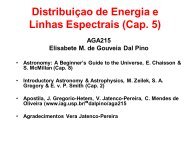342 T. Miyoshi, K. Kusano / Journal of Computational Physics 208 (2005) 315–344Fig. 12. Gray-scale images of the temperature distribution in the Orszag–Tang vortex problem at t = p <strong>for</strong> (left to right) the <strong>HLL</strong><strong>solver</strong>, the <strong>HLL</strong>D <strong>solver</strong>, the Roe scheme at N = 200, and the reference solution. The left half of the domain is shown.3.02.0<strong>HLL</strong> <strong>solver</strong><strong>HLL</strong>D <strong>solver</strong>Roe scheme1.0<strong>HLL</strong> <strong>solver</strong><strong>HLL</strong>D <strong>solver</strong>Roe scheme1.00.00 1 2 3 4 5 60.50 1 2 3 4 5 6Fig. 13. One-dimensional temperature distribution in the same problem as in Fig. 12 along (left) y = 0.64p, (right) y = p. <strong>for</strong> the <strong>HLL</strong><strong>solver</strong>, the <strong>HLL</strong>D <strong>solver</strong>, and the Roe scheme. The solid line shows the reference solution in each panel.7. ConclusionsWe have proposed the <strong>multi</strong>-<strong>state</strong> <strong>HLL</strong> <strong>approximate</strong> <strong>Riemann</strong> <strong>solver</strong> <strong>for</strong> the <strong>ideal</strong> MHD equations,named as <strong>HLL</strong>D <strong>approximate</strong> <strong>Riemann</strong> <strong>solver</strong>. The <strong>HLL</strong>D <strong>Riemann</strong> <strong>solver</strong> was constructed under theassumption that the normal velocity is constant over the <strong>Riemann</strong> fan. This assumption naturally concludedthat the four <strong>state</strong>s approximation in the <strong>Riemann</strong> fan are appropriate <strong>for</strong> B x 6¼ 0, whereas theintermediate <strong>state</strong>s are reduced to the two <strong>state</strong>s when B x = 0. We showed that the <strong>HLL</strong>D <strong>solver</strong> can exactlyresolve all isolated discontinuities in the MHD system as well as isolated fast shocks. We also provedanalytically that the <strong>HLL</strong>D <strong>solver</strong> is positively conservative if proper inequalities <strong>for</strong> the maximum andminimum signal speeds are satisfied. Especially, it was shown that those conditions are quite similar to theconditions <strong>for</strong> the <strong>HLL</strong>C <strong>solver</strong> except <strong>for</strong> the difference of the expressions <strong>for</strong> the maximum and minimumeigenvalues. Thus, we considered that the <strong>HLL</strong>D <strong>solver</strong> <strong>for</strong> MHD is a natural extension of the<strong>HLL</strong>C <strong>solver</strong> <strong>for</strong> the Euler equations. Also, several numerical tests demonstrated that the <strong>HLL</strong>D <strong>solver</strong>is accurate enough in comparison with the linearized <strong>Riemann</strong> <strong>solver</strong> while keeping its robustness. From atypical two-dimensional test, it was considered that the extension to <strong>multi</strong>-dimensions in the <strong>HLL</strong>D <strong>solver</strong>
T. Miyoshi, K. Kusano / Journal of Computational Physics 208 (2005) 315–344 343may be applicable in a similar way as in the linearized <strong>Riemann</strong> <strong>solver</strong>. The ratios of CPU time s <strong>for</strong> theOrszag–Tang vortex problem at N = 400 in our codes are (s <strong>HLL</strong> :s <strong>HLL</strong>D :s Roe ) = (1:1.35:2.67) in the part ofthe flux calculation and (1:1.13:1.69) over the whole simulation run, although the actual efficiency <strong>for</strong> thewhole simulation much depends not only on the optimization of the code but also on the algorithm of thedivergence cleaning method, the higher-order extension method, the time integration method, and so on.Thus, the <strong>HLL</strong>D <strong>solver</strong> seems to be effective particularly in regard to robustness and efficiency rather thanthe Roe scheme, although exact positivity preserving property in <strong>multi</strong>-dimensions may not be necessarilyassured even in the <strong>HLL</strong>D <strong>solver</strong>. Also, the <strong>HLL</strong>D <strong>solver</strong> may be applicable to the modified MHD systemas subtracting off the background potential field first proposed by Tanaka [28] and applied by many others[18,22,25]. In this modified system, the <strong>HLL</strong>D <strong>solver</strong> will be constructed by replacing the total pressurep T with the fluctuating part of the total pressure ~p T ¼ p T jB 0 j 2 =2in(41) <strong>for</strong> example. A detailed algorithmwill be given in the future paper. These all results indicate that the <strong>HLL</strong>D <strong>Riemann</strong> <strong>solver</strong> <strong>for</strong> the<strong>ideal</strong> MHD equations can be an alternative to the linearized <strong>Riemann</strong> <strong>solver</strong> <strong>for</strong> MHD.AcknowledgementsPart of this work was financially supported by the collaboration program of Japan Atomic EnergyResearch Institute (JAERI), that was arranged by Y. Kishimoto and Y. Ishii of NumericalEXperiment of Tokamak (NEXT) group at Naka Fusion Research Establishment, JAERI. We thankthe anonymous reviewers <strong>for</strong> constructive comments and suggestions improving the readability of thepaper.References[1] D.S. Balsara, Linearized <strong>for</strong>mulation of the <strong>Riemann</strong> problem <strong>for</strong> adiabatic and isothermal magnetohydrodynamics, Astrophys. J.Supp. 116 (1998) 119.[2] P. Batten, N. Clarke, C. Lambert, D.M. Causon, On the choice of wave speeds <strong>for</strong> the <strong>HLL</strong>C <strong>Riemann</strong> <strong>solver</strong>, SIAM J. Sci.Statist. Comput. 18 (1997) 1553.[3] J.U. Brackbill, D.C. Barnes, The effect of nonzero $ Æ B on the numerical solution of the magnetohydrodynamic equations, J.Comput. Phys. 35 (1980) 426.[4] M. Brio, C.C. Wu, An upwind differencing scheme <strong>for</strong> the equations of <strong>ideal</strong> magnetohydrodynamics, J. Comput. Phys. 75 (1988)400.[5] P. Cargo, G. Gallice, Roe matrices <strong>for</strong> <strong>ideal</strong> MHD and systematic construction of Roe matrices <strong>for</strong> systems of conservation laws,J. Comput. Phys. 136 (1997) 446.[6] W. Dai, P.R. Woodward, An <strong>approximate</strong> <strong>Riemann</strong> <strong>solver</strong> <strong>for</strong> <strong>ideal</strong> magnetohydrodynamics, J. Comput. Phys. 111 (1994) 354.[7] S.F. Davis, Simplified second-order Godunov-type methods, SIAM J. Sci. Statist. Comput. 9 (1988) 445.[8] A. Dedner, F. Kemm, D. Kröner, C.-D. Munz, T. Schnitzer, M. Wesenberg, Hyperbolic divergence cleaning <strong>for</strong> the MHDequations, J. Comput. Phys. 175 (2002) 645.[9] B. Einfeldt, C.D. Munz, P.L. Roe, B. Sjögreen, On Godunov-type methods near low densities, J. Comput. Phys. 92 (1991) 273.[10] C.R. Evans, J.F. Hawley, Simulation of magnetohydrodynamic flows: a constrained transport method, Astrophys. J. 332 (1988)659.[11] S.A.E.G. Falle, S.S. Komissarov, P. Joarder, A <strong>multi</strong>dimensional upwind scheme <strong>for</strong> magnetohydrodynamics, Mon. Not. R.Astron. Soc. 297 (1998) 265.[12] J. Gressier, P. Villedieu, J.M. Moschetta, Positivity of flux vector splitting schemes, J. Comput. Phys. 155 (1999) 199.[13] K.F. Gurski, An <strong>HLL</strong>C-type <strong>approximate</strong> <strong>Riemann</strong> <strong>solver</strong> <strong>for</strong> <strong>ideal</strong> magnetohydrodynamics, SIAM J. Sci. Comput. 25 (2004)2165.[14] A. Harten, J.M. Hyman, Self adjusting grid methods <strong>for</strong> one-dimensional hyperbolic conservation laws, J. Comput. Phys. 50(1983) 235.[15] A. Harten, P.D. Lax, B. van Leer, On upstream differencing and Godunov-type schemes <strong>for</strong> hyperbolic conservation laws, SIAMRev. 25 (1983) 35.







